What Are Tea Eggs?
Tea eggs are a flavorful Chinese snack made by simmering boiled eggs in a spiced tea marinade. The eggs have a distinctive marble-like pattern on their surface, created by cracking the shells before steeping. The result is a visually appealing and savory treat with layers of aromatic flavor. Tea eggs are commonly enjoyed as a snack or side dish across various cultures.
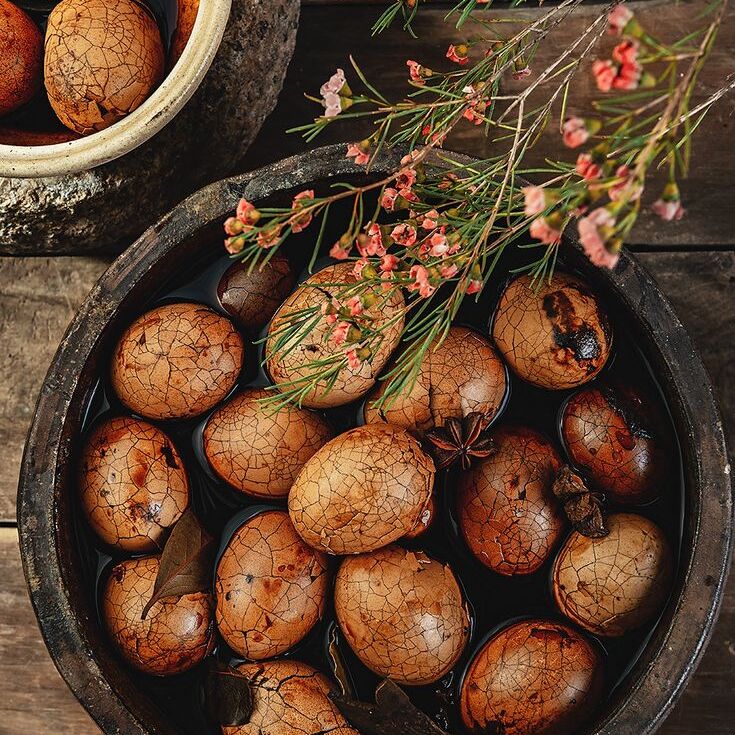
History and Origin of Tea Eggs
Tea eggs originated in China centuries ago as a simple street food. Vendors sold them to workers looking for affordable, tasty snacks. The process of steeping eggs in tea and spices was developed to enhance their flavor while reducing food waste. Over time, tea eggs became a cultural icon, beloved for their unique appearance and taste.
Popularity of Tea Eggs in Different Cultures
Tea eggs have gained popularity worldwide, especially in neighboring Asian countries like Taiwan and Malaysia. In Taiwan, they are often served in convenience stores, while in Malaysia, they are part of festive celebrations. Tea eggs are also enjoyed in Western countries, where food enthusiasts appreciate their intricate patterns and rich taste. These eggs symbolize the creativity and fusion of culinary traditions globally.
Ingredients Needed for Making Tea Eggs
Tea eggs require a mix of simple and flavorful ingredients. These create the distinct taste that makes them unique. Here’s a breakdown of what you’ll need:
Traditional Ingredients
- Eggs: Use medium to large chicken eggs. Fresh eggs work best for ideal texture.
- Tea Leaves: Black tea is traditional, but oolong or pu-erh tea works as well.
- Soy Sauce: Adds a salty, umami depth to the marinade.
- Star Anise: Brings a warm, licorice-like flavor.
- Cinnamon Sticks: Provides sweetness and aromatic spice.
- Cloves: A small amount for added complexity.
- Bay Leaves: Enhances the overall flavor profile.
- Sugar: Balances the savory and salty flavors.
- Salt: Essential for seasoning the eggs.
- Water: Acts as the base for the marinade.
These traditional ingredients are key to making authentic Chinese tea eggs. They create a balanced, savory flavor combination.
Optional Add-Ons for Flavor Variations
While the traditional recipe is classic, optional ingredients can add variety:
- Orange Peel: Infuses a citrusy hint to the marinade.
- Sichuan Peppercorns: Adds a mild numbing, spicy sensation.
- Garlic Cloves: Boosts savory depth.
- Ginger Slices: Gives a warming kick.
- Five-Spice Powder: A blend of aromatics for richer taste.
- Green or Jasmine Tea: For a lighter, floral flavor.
- Chili Flakes: Introduces a spicy edge to the eggs.
These add-ons allow you to customize tea eggs to your taste preferences. Experiment to discover your perfect combination.
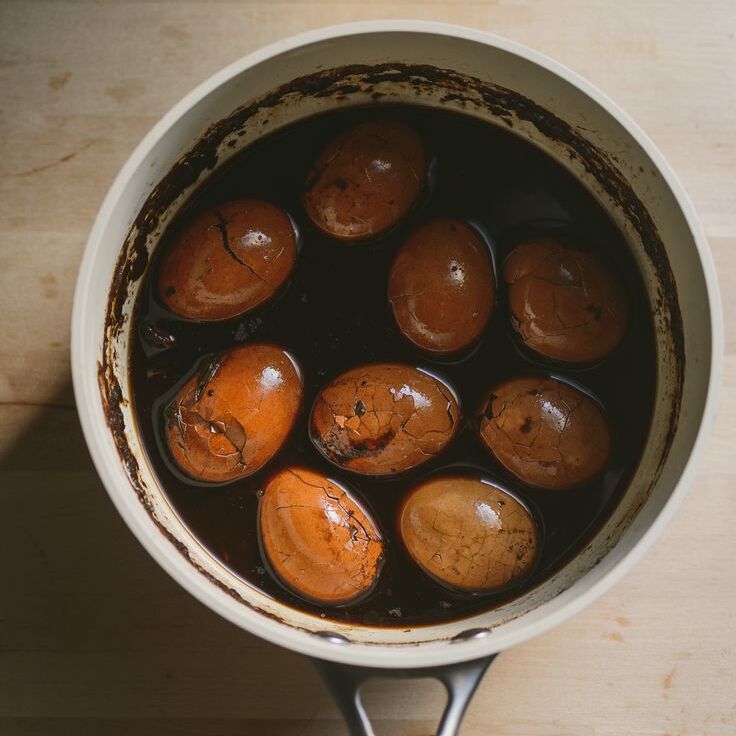
Step-by-Step Guide to Making Tea Eggs
Tea eggs may look intricate, but the process is simple and enjoyable. This step-by-step guide will ensure your tea eggs turn out perfectly flavorful and beautifully marbled.
Preparing the Eggs
- Boil the Eggs: Place the eggs in a pot and cover them with water. Bring the water to a boil and cook for 8–10 minutes until fully hard-boiled.
- Cool and Crack: Transfer the boiled eggs to a bowl of cold water to cool. Gently tap the eggshells all over with the back of a spoon to create small cracks. Ensure the shell stays intact to hold the egg together.
- Prepare for Marination: Leave the cracked eggs in their shells. The cracks allow the marinade to seep in, giving the eggs their signature marble effect.
Creating the Tea Marinade
- Choose Your Tea: Use black tea for a traditional flavor. You can use oolong or pu-erh tea for variations.
- Combine Ingredients: In a pot, combine tea leaves, soy sauce, star anise, cinnamon sticks, cloves, bay leaves, sugar, and salt. Add water to cover the eggs.
- Optional Add-Ons for Flavor: Include optional ingredients like orange peel, Sichuan peppercorns, garlic, ginger, or five-spice powder for customized flavors.
- Boil the Marinade: Bring the mixture to a boil. Reduce heat and simmer for 5–10 minutes. This allows the flavors to blend thoroughly.
Cooking and Steeping Process
- Add the Eggs to the Marinade: Carefully place the cracked eggs into the prepared marinade.
- Simmer the Eggs: Simmer the eggs in the marinade for 20–30 minutes. Stir occasionally so the eggs soak evenly.
- Steep for Flavor: Turn off the heat and let the eggs steep in the marinade for at least 2–4 hours. For deeper flavor, leave them overnight in the refrigerator.
- Remove and Serve: Peel and enjoy your tea eggs as a snack or side dish. For stronger flavors, let them steep longer.
By following this guide, you’ll create tea eggs that are as tasty as they are visually stunning. Experiment with timing and flavors to suit your palate!
Tips for Achieving Perfect Marbled Eggs
Making perfect tea eggs requires attention to detail in cracking, flavor balance, and steeping.
How to Create the Right Crack Pattern
- Tap Evenly: Use the back of a spoon to tap the shells evenly all around.
- Avoid Large Breaks: Ensure the cracks are small and consistent to create the marble effect.
- Keep Shells Intact: Don’t peel the shell; it holds the egg together while marinating.
- Practice Makes Perfect: Experiment with different tapping techniques for the best results.
Balancing Flavor and Saltiness
- Taste-Test the Marinade: Always taste before adding the eggs. Adjust soy sauce, sugar, and salt to your liking.
- Use Fresh Ingredients: Ensure spices are fresh for maximum aroma and flavor.
- Avoid Over-salting: Start with less salt, as the soy sauce already adds saltiness.
- Adjust Sugars: A touch of sugar balances salty and bitter flavors from the tea and spices.
Best Steeping Times for Maximum Flavor
- Minimum Steeping: Allow eggs to steep in the marinade for at least 2–4 hours.
- Overnight Steeping: For richer flavors, refrigerate eggs in marinade overnight.
- Stir Occasionally: Rotate the eggs while steeping to ensure even absorption of flavors.
- Monitor Timing: Longer steeping yields stronger flavors, but avoid overly bitter results from tea.
By mastering these tips, your tea eggs will look stunning and taste amazing!
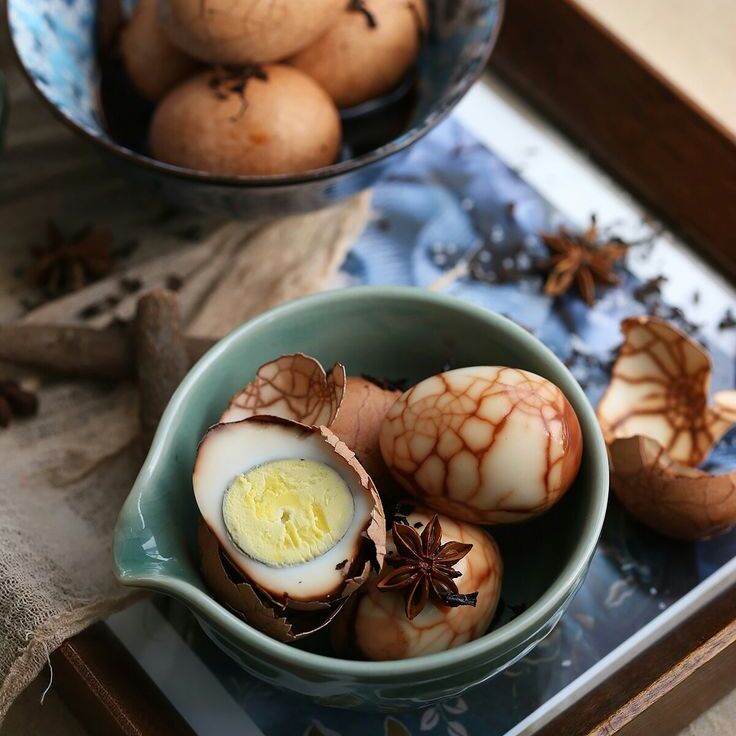
Regional Variations of Marbled Eggs
Tea eggs have adapted in unique ways across different regions. Each version brings distinct flavors and styles to this iconic dish.
Chinese Tea Eggs
Chinese tea eggs are the original version of this snack. They are typically made with black tea, soy sauce, star anise, and cinnamon sticks. These ingredients create a savory and aromatic flavor. The preparation emphasizes simplicity while retaining the traditional marble effect. Often sold by street vendors, they remain an affordable and popular snack across China.
Taiwanese Tea Eggs
Taiwanese tea eggs are widely recognized for their rich taste and accessibility. Convenience stores like 7-Eleven often sell them, making them a common grab-and-go snack. The recipe includes soy sauce, tea, and a mix of local spices like five-spice powder. Slow cooking is key to infusing deep, bold flavors. These eggs are particularly flavorful and cherished by locals and tourists alike.
Other Global Adaptations
Tea eggs have inspired variations in many parts of the world. In Malaysia, they are commonly prepared during festive occasions, incorporating ingredients like pandan leaves for a fragrant twist. In Western countries, food enthusiasts experiment with diverse spices, teas, and herbs. Some incorporate green or jasmine tea for a lighter, floral flavor. These global reinventions show how tea eggs have transcended cultures while keeping their core essence.
Serving and Enjoying Marbled Eggs
Tea eggs are versatile and can be enjoyed in various ways. They pair well with many types of meals or snacks. Their savory, spiced flavor complements both simple and complex dishes.
Pairing Tea Eggs with Other Foods
- Rice Dishes: Serve tea eggs with steamed rice for a fulfilling Asian-inspired meal.
- Noodles: Pair them with ramen or stir-fried noodles to add protein and flavor.
- Soups: Use tea eggs as a garnish in brothy soups for a touch of spice.
- Salads: Slice the eggs over salads to elevate the taste with their umami depth.
- Bread or Pastries: Enjoy them alongside buns or pastries for a balanced snack or breakfast.
- Congee: Add tea eggs to congee for traditional comfort food with extra flavor.
Tea eggs work well in these combinations, enhancing both taste and texture.
Serving Suggestions for Snacks or Meals
- As a Snack: Eat tea eggs on their own for a quick and tasty snack.
- Picnic Option: They are portable and mess-free, making them ideal for outdoor picnics.
- Party Appetizers: Serve sliced quarters on a platter for an eye-catching appetizer.
- Lunchboxes: Include them in a bento box or meal prep for an easy protein addition.
- Festive Celebrations: Use them in cultural or holiday gatherings to share their traditional appeal.
These ideas showcase the adaptability of tea eggs, letting you enjoy them anytime, anywhere.
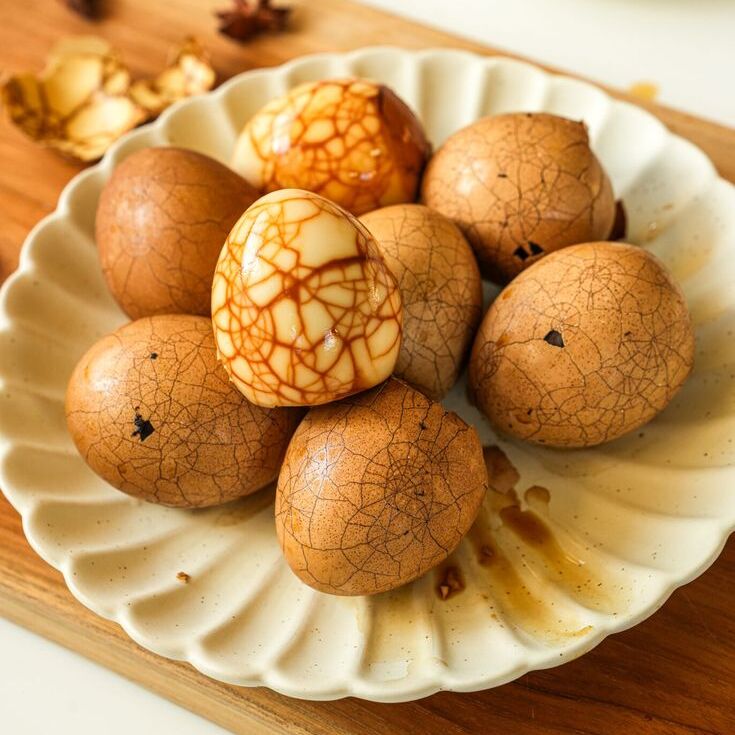
Storing and Reheating Marbled Eggs
Proper storage and reheating methods ensure tea eggs remain tasty and safe to eat. Follow these steps to keep your tea eggs fresh and maintain their rich flavors.
How to Store Tea Eggs Safely
- Cool Thoroughly Before Storing: Let tea eggs cool completely after cooking before refrigeration.
- Use an Airtight Container: Place cooled tea eggs and some marinade in an airtight container to retain moisture.
- Refrigerate Promptly: Store the container in the refrigerator at or below 40°F to prevent spoilage.
- Limit Storage Time: Consume tea eggs within 3 to 5 days for the best taste and safety.
- Avoid Freezing: Freezing tea eggs can ruin their texture and flavor, so refrigeration is recommended.
Proper storage preserves the egg’s signature flavor and keeps it safe to eat.
Tips for Reheating Without Losing Flavor
- Heat Using the Marinade: Reheat tea eggs gently in their marinade over low heat to maintain flavor.
- Avoid Boiling: Do not boil during reheating, as it can toughen the eggs.
- Microwaving Option: Place eggs in a microwave-safe bowl, cover with marinade, and heat briefly to warm.
- Steam for Gentle Reheating: Steam the tea eggs over hot water to preserve moisture and avoid overcooking.
- Serve at Room Temperature: Tea eggs are also delicious served at room temperature without reheating.
By following these tips, your tea eggs will remain flavorful, tender, and safe to enjoy!
Frequently Asked Questions About Marbled Eggs
How Long Can Marbled Eggs Be Stored?
Tea eggs can be safely stored in the refrigerator for up to five days. Always use an airtight container to prevent drying out. Keeping them immersed in the marinade helps preserve both moisture and flavor. This also enhances the marbling effect. Store them at or below 40°F to prevent bacterial growth. Avoid placing them in the fridge door where temperatures fluctuate. For best results, refrigerate the eggs within two hours of cooking. Do not leave them at room temperature overnight. Always check for a foul odor or unusual texture before eating. Mold or slimy surfaces mean the eggs are no longer safe. Never consume questionable eggs.
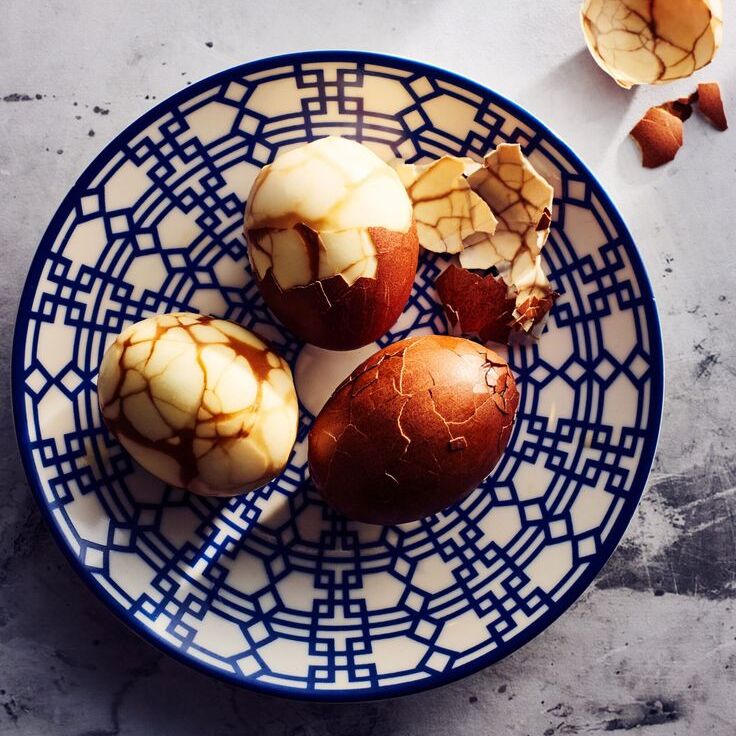
Freezing tea eggs is not recommended. The texture will change significantly. Frozen and thawed eggs may turn rubbery and lose their flavor. Ice crystals can break down the egg structure. This results in a dry and crumbly bite. For longer enjoyment, prepare smaller batches more frequently. Label your container with the date made. This helps you track freshness and avoid waste. When reheating, use gentle heat. Never microwave with the shell on. Steam or soak briefly in warm water instead.
Can You Use Different Types of Tea for Brewing?
Yes, various teas can change the flavor dramatically. Black tea is the most common base. It brings a rich, strong taste that pairs well with soy sauce. Oolong tea gives a softer, more floral note. It creates a smooth and elegant broth. Pu-erh tea offers an earthy, aged character. This adds depth and warmth to the eggs. Jasmine tea contributes a delicate floral aroma. Green tea delivers a fresher, grassier profile.
Always balance the tea type with your spice blend. Too much tea can create bitterness. Too little will lack flavor depth. Combine your chosen tea with classic spices like star anise and cinnamon. Add soy sauce, sugar, and ginger for harmony. For a unique twist, try lapsang souchong or Earl Grey.
Are Tea Eggs Healthy?
Tea eggs are a healthy snack with protein and minimal fats. They are low in calories and high in essential nutrients, including vitamins B2, B12, and selenium. The marinade adds antioxidants from tea and spices. However, monitor salt and soy sauce intake to ensure moderation. For a healthier version, adjust sugar and salt levels according to dietary needs.